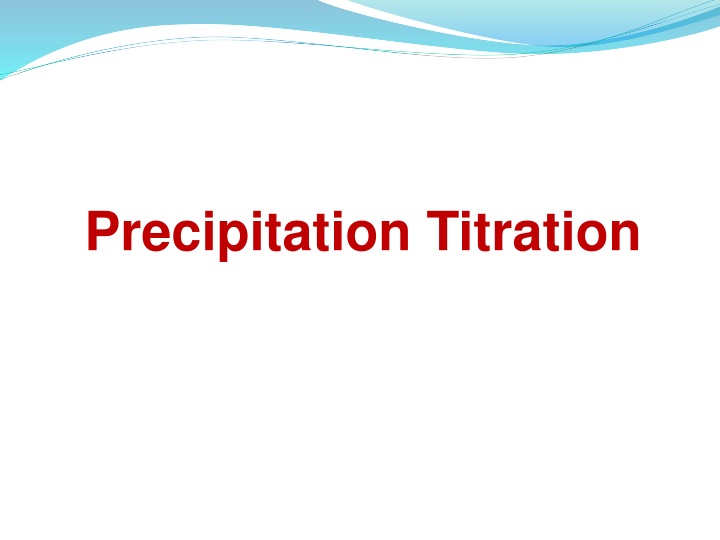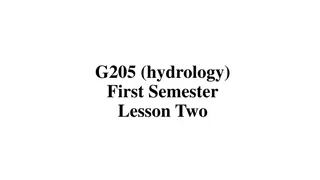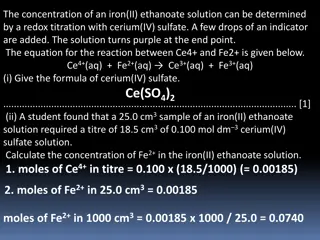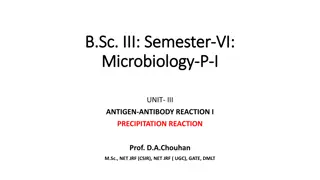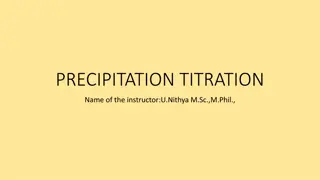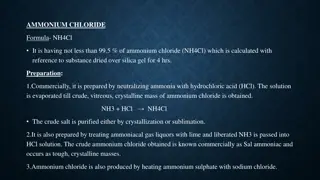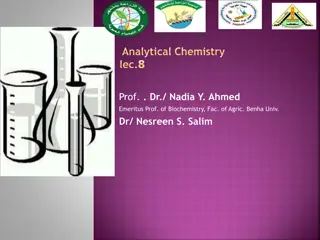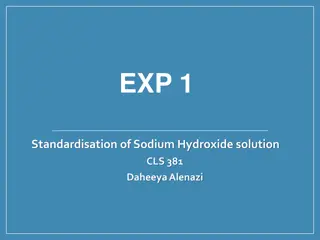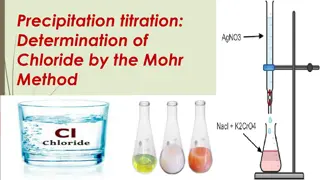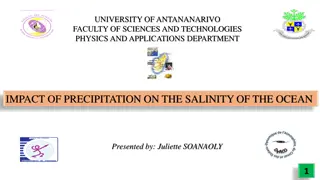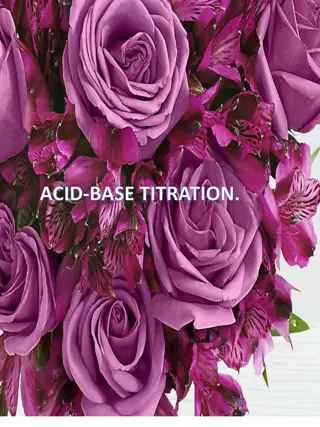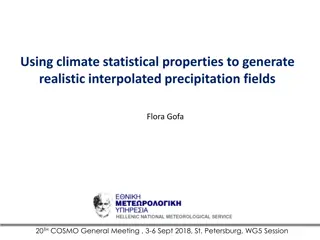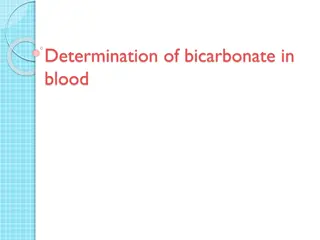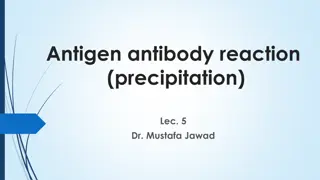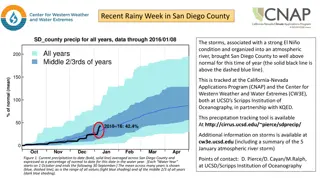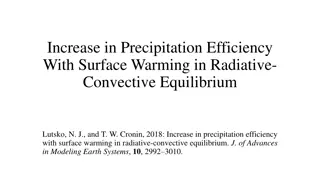Precipitation Titration Methods
Precipitation titration is a vital process in titrimetric analysis, involving the formation of slightly soluble precipitates. The method utilizes silver nitrate as the reagent in Argentometric analysis, where insoluble compounds are formed to determine endpoints using various indicators like K2CrO4 and Fe(NO3)2. Explore its applications and experimental procedures.
Download Presentation

Please find below an Image/Link to download the presentation.
The content on the website is provided AS IS for your information and personal use only. It may not be sold, licensed, or shared on other websites without obtaining consent from the author.If you encounter any issues during the download, it is possible that the publisher has removed the file from their server.
You are allowed to download the files provided on this website for personal or commercial use, subject to the condition that they are used lawfully. All files are the property of their respective owners.
The content on the website is provided AS IS for your information and personal use only. It may not be sold, licensed, or shared on other websites without obtaining consent from the author.
E N D
Presentation Transcript
Precipitation Titrations: The most important precipitation processes in titrimetric analysis use the silver nitrate (AgNO3) as the reagent (Argentometric method). Argentometric is derived from the Latin noun argentum, which means silver. Precipitation titration includes the formation of insoluble compounds, i.e. one of the products of the reaction must be slightly soluble precipitate (low Ksp).
Example: AgNO3 + NaCl AgCl + NaNO3 ppt Ag++ Cl- AgCl KSP= [??+1] [Cl -1]
The important methods used for determining end points in precipitation reactions are: 1- Formation of a colored precipitate (Mohr method) using K2CrO4 as indicator. 2- Formation of a soluble colored compound (Volhard method) using Fe(NO3)2 or FeCl3 as indicator. 3- Use of adsorption indicators (Fajans Method) using Fluorescein as indicator.
Experiment No. 4 Standardization of silver nitrate (AgNO3) solution & determination of chloride ion (Cl-) using potassium chromate as indicator (Mohr method)
Mohr method used for determination of Cl- and Br- ions. In the titration of Cl- with AgNO3 solution, a small quantity of K2CrO4 solution is added to serve as indicator. At end point chromate ion (CrO4-2) combine with Ag+ ions to form the sparingly soluble red silver chromate (Ag2CrO4 ). AgNO3 + NaCl AgCl + NaNO3 white ppt 2 AgNO3 + K2CrO4 Ag2CrO4 + 2 KNO3 Reddish - brown ppt In practice, a more dilute solution (0.003 0.004 M) of K2CrO4 is generally used.
The titration should be carried out in neutral solution or in very faintly alkaline solution, i.e. within the pH range 6.5 9. because in acid solution the following reaction occurs: 2CrO4-2 + 2 H+ 2 HCrO4- Cr2O7-2 + H2O HCrO4- is a weak acid, consequently the CrO4-2 ion concentration is reduced, hence the distinct end point not obtained. In very strong alkaline solution AgOH and Ag2O are precipitate respectively. 2 Ag+ + 2 OH- 2 AgOH(s) Ag2O(s) + H2O
The titration should be performed at room temperature because the solubility of silver chromate Ag2CrO4increases with rising temperature.
The mohr method cannot be used for determination of iodide (I-) and thiocyanide (SCN-) ions . Because silver iodide (AgI) and silver thiocyanide (AgSCN) formed which adsorb chromate ions (CrO4-2) so strongly that false and indistinct end point is obtained.
Solutions of AgNO3 should be protected from light and are best stored in dark colored glass bottles. Because the light reduces the silver ion (Ag+) to the black precipitate (Ag): AgNO3 Ag + NO + O2 Ag+ + e Ag (Reduction)
Preparation of solutions: Prepare approximately 0.01 N AgNO3 solution in 250 mL of distilled water. N eq.wt V (mL) eq.wt of AgNO3 =F.wt of AgNO3 Wt = n 1000 1 107.9 + 1 14 + 3 16 1 1 = 0.01 169 250 = 169.9 g/mol = 1000 = 0.4247 gm Dissolve 0.4247gm of AgNO3 in 250 mL of distilled water to obtain approximately 0.1N AgNO3 solution.
2- Prepare 0.01 N standard NaCl solution in 250 mL of distilled water. N eq.wt V (mL) F.wt of NaCl n Wt = eq.wt of NaCl = 1000 1 23 + 1 35.5 1 1 = 0.01 58.5 250 = = 58.5 g/mol 1000 = 0.14625 gm Dissolve 0.1462gm of NaCl in 250 mL of distilled water to obtain 0.01N NaCl solution.
Procedure: 1. Pipet 5 ml of 0.01N standard NaCl solution into a conical flask. 2. Add 2 drops of K2CrO4 indicator. The solution will be yellow. 3. Titrate the solution with AgNO3solution slowly from the burette, swirling the solution until the red color formed by addition of each drop. 4. Continue the addition drop wise until a faint distinct change in color achieves (Reddish brown ppt). Repeat the titration three (3) times. V NaCl (ml) VAgNO3 (ml) 5 5 5 V1 V2 V3 V1 + V2 + V3 3 V average = = (Y) ml AgNO3
10 ml of NaCl (0.01N) AgNO3solution 2-3 drops of K2CrO4 10 ml of NaCl 0.01N 2-3 drops of K2CrO4 The Colour changed from yellow to redish-brown (1) (2) (3) Vaverage= Volume (mL) of AgNO3 react with NaCl and indicator (K2CrO4)
10 ml of D.W AgNO3solution 2-3 drops of K2CrO4 10 ml of D.W. 2-3 drops of K2CrO4 The Colour changed from yellow to redish-brown (1) (2) (3) Vblank = Volume (ml) of AgNO3 react with just indicator (K2CrO4)
VAgNO3= Volume (mL) of AgNO3 react with just NaCl. = Vaverage - Vblank = ( Y) mL Calculation At the equivalence point no. of milliequivalence of NaCl no. of milliequivalence of AgNO3= (N1 V1)AgNO3= (N2 V2) NaCl 0.01 10 NAgNO3 Y = 0.01 10 Y NAgNO3= ( ) eq/L NAgNO3=
